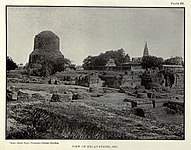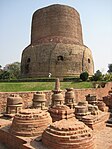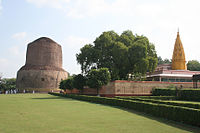Dhamek Stupa
| Dhamek Stupa धमेख स्तूप (in Hindi) | |
|---|---|
 | |
| Religion | |
| Affiliation | Buddhism |
| Status | Preserved |
| Location | |
| Location | |
| Administration | Archaeological Survey of India |
| Geographic coordinates | 25°22′51″N 83°01′28″E / 25.3808°N 83.0245°E |
| Architecture | |
| Type | Stupa |
| Style | Buddhist, Mauryan art |
| Completed | 5th-6th century AD[1] |
| Specifications | |
| Length | 28 metres (92 feet)[2] |
| Width | 28 metres (92 feet)[2] |
| Height (max) | 43 metres (141 feet)[2] |
| Materials | white makrana marble |
Dhamek Stupa (also spelled Dhamekh and Dhamekha) is a massive stupa located at the archaeological site of Sarnath in the state of Uttar Pradesh, India.[3] Dhamek Stupa marks the precise location where the Buddha preached his first discourse to his first five disciples (Kaundinya, Assaji, Bhaddiya, Vappa and Mahanama), and where all five eventually became fully liberated.[4]
Etymology
The name Dhamek derives from the Sanskrit word dharmeksā, which means "pondering of the law" in the Sanskrit language.[5]
Location
Dhamek Stupa is located 180 metres (590 feet) to the east of Dharmarajika Stupa at the archaeological site of Sarnath. Sarnath is located 12 kilometres (7.5 miles) to the northeast of Varanasi, in Uttar Pradesh, India.
Description
Dhamek Stupa is the most massive structure in Sarnath.[6] In its current shape, the stupa is a solid cylinder of bricks and stone reaching a height of 43.6 meters and having a diameter of 28 meters. The basement seems to have survived from Ashoka's structure, while the stone facing displays delicate floral carvings characteristic of the Gupta era. The wall is covered with exquisitely carved figures of humans and birds, as well as inscriptions in Brahmi script.[7] The stupa was enlarged on six occasions but the upper part is still unfinished.[8] While visiting Sarnath in 640 CE, Xuanzang recorded that the colony had over 1,500 priests and the main stupa was nearly 300 feet (91 m) high.[9]
An Ashoka pillar with an edict engraved on it stands near the site.
History
Dhamek Stupa marks the precise location where the Buddha preached his first discourse to his first five disciples (Kaundinya, Assaji, Bhaddiya, Vappa and Mahanama), and where all five eventually became fully liberated.[4] This event marked the formation of the sangha. Several of the ancient sources describe the site of this first sermon as a Mriga-dayaa-vanam or a sanctuary for animals. (In Sanskrit, the word mriga is used in the sense of game animals, with deer being the most common).
After the parinirvana of the Buddha in 544 BCE, his remains were cremated and the ashes were divided and buried under eight stupas, with two further stupas encasing the urn and the embers. Dhamek Stupa was presumably among these eight stupas, and Mauryan King Ashoka may have commissioned its expansion.[10] But the current Dhamek Stupa, as visible today, was conclusively dated to the Gupta period, in the 5th-6th century CE.[11][1]
A 17th-century Jain manuscript describes a Jain temple in Varanasi as a pilgrimage site for Jains. The temple is located close to "a famous Bodisattva sanctuary" at a place called dharmeksā.[5]
In what is the first incontrovertible reference to the ruins at Sarnath, Jonathan Duncan (a charter member of the Asiatic Society and later Governor of Bombay) described the discovery of a green marble reliquary encased in a sandstone box in the relic chamber of a brick stupa at that location. The reliquary was discovered in January 1794, during the dismantling of a stupa (referred to by Alexander Cunningham as stupa "K" or the "Jagat Singh stupa",[12] later identified as the Dharmarajika Stupa)[13] by employees of Zamindar Jagat Singh (the dewan of Maharaja Chait Singh, the Raja of Benares).[14] Duncan published his observations in 1799.[15][16][17] The reliquary contained a few bones and some pearls, which were subsequently thrown into the Ganges river.[18] The reliquary itself has also disappeared, although the outer sandstone box was replaced in the relic chamber, where it was rediscovered by Cunningham in 1835.[14] The bricks of the stupa were hauled off and used for the construction of the market in Jagatganj, Varanasi.[19] Jagat Singh and his crew also removed a large part of the facing of the Dhamek Stupa, and removed several Buddha statues which he retained at his house in Jagatganj.[20]
Gallery
-
As it appeared in 1814
-
As it appeared in 1891
-
As it appeared in 1905. Camera angle from the ruins of the ancient Mulagandha Kuty Vihara towards the Dhamek Stupa; the Sri Digamber Jain temple can be seen on the right side of the photograph.
-
As it appeared in 2008
-
Dhamekh Stupa wall close-up, as it appeared in 2008
-
As it appeared in 2009
-
As it appeared in 2009 (close-up view)
-
Plaque at Sarnath historical site, outlining the history of Dhamekh Stupa (2010)
-
As it appeared in 2019. Camera angle from the ruins of the ancient Mulagandha Kuti Vihar towards the Dhamek Stupa; the Shreyanshnath Jain Temple can be seen on the right side of the photograph (the Panchayatan Temple can also be seen in the middle).
References
- ^ a b Dodson, Michael S. (31 January 2021). Banaras: Urban Forms and Cultural Histories. Taylor & Francis. p. 75, note 39. ISBN 978-1-000-36564-1.
However, the Dhamek was conclusively dated as a Gupta period (5th-6th century) monument (...) and was shown not to have been built by the Mauryas Emperor Ashoka
- ^ a b c "Sarnath attractions that you shouldn't skip". The Times of India.
- ^ "Dhamekh Stupa Sarnath, Varanasi India". iloveindia.com.
- ^ a b "Historical Places of the Buddha |". Igatpuri, Maharashtra, India: Vipassana Research Institute. Retrieved 13 December 2022.
- ^ a b Oertel 1908, p. 60.
- ^ "Dhamekh Stupa". Varanasicity.com. Retrieved 16 October 2006.
- ^ "Dhamekh Stupa". Retrieved 19 September 2006.
- ^ Bradnock, Robert W. Footprint India. Footprint Travel Guides, 2004. ISBN 1-904777-00-7. Page 191.
- ^ Arnett, Robert A. India Unveiled. Atman Press, 2006. ISBN 0-9652900-4-2.
- ^ "Stupas". Indian Heritage. Archived from the original on 8 January 2007. Retrieved 20 November 2006.
- ^ Sir Banister Fletcher's a History of Architecture, 20th ed. (ed. by Dan Cruickshank). Architectural Press, 1996. ISBN 0-7506-2267-9. Page 646.
- ^ Oertel 1908, p. 65.
- ^ Archaeological Survey of India (2014). "Dhamek Stupa". Our Monuments. Sarnath, Varanasi, Uttar Pradesh: Archaeological Survey of India - Sarnath Circle. Retrieved 1 January 2023.
- ^ a b Oertel 1908, pp. 61–62.
- ^ Duncan 1799, pp. 131–133.
- ^ Cunningham 1871, pp. 118–119.
- ^ Asher 2020, p. 22.
- ^ Sahni 1917, pp. 17–20.
- ^ Sherring 1868, p. 26.
- ^ Oertel 1908, pp. 62–64.
Cited works
- Asher, Frederick M. (2020). Sarnath: A Critical History of the Place Where Buddhism Began. Los Angeles: Getty Research Institute. ISBN 978-1606066164.
- Cunningham, Alexander (1871). "Banaras Sarnath". Four reports made during the years 1862-63-64-65. Vol. 1. Shimla, Himachal Pradesh, India: Archaeological Survey of India. pp. 103–130.
- Duncan, Johnathan (1799). "An Account of the Discovery of Two Urns in the Vicinity of Benares". Transactions of the Society Instituted in Bengal, for enquiring into the History and Antiquities, the Arts, Sciences and Literature, of Asia. 5: 131–3.
- Oertel, Friedrich Oscar (1908). "Excavations at Sarnath". Archaeological Survey of India Annual Report, 1904–1905. Calcutta: Superintendent Government Printing, India.
- Sahni, Daya Ram (1917). Guide to the Buddhist ruins of Sarnath. Calcutta: Archaeological Survey of India.
- Sherring, Matthew Atmore (1868). Benares: The Sacred City of the Hindus. Delhi: B. R. Publishing Corporation.













